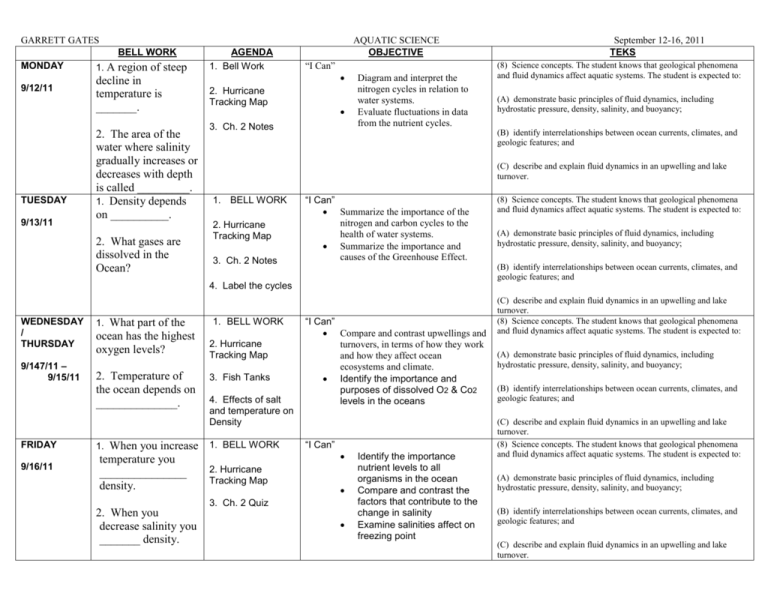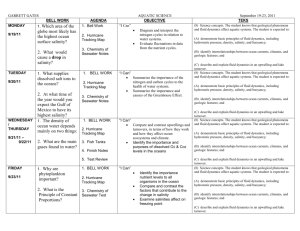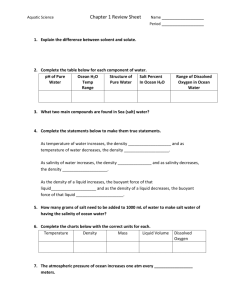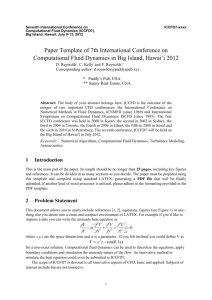OBJECTIVE
advertisement

GARRETT GATES BELL WORK MONDAY 9/12/11 TUESDAY 9/13/11 1. A region of steep decline in temperature is _______. 2. The area of the water where salinity gradually increases or decreases with depth is called _________. 1. Density depends on __________. 2. What gases are dissolved in the Ocean? AGENDA 1. Bell Work AQUATIC SCIENCE OBJECTIVE “I Can” 2. Hurricane Tracking Map 3. Ch. 2 Notes Diagram and interpret the nitrogen cycles in relation to water systems. Evaluate fluctuations in data from the nutrient cycles. September 12-16, 2011 TEKS (8) Science concepts. The student knows that geological phenomena and fluid dynamics affect aquatic systems. The student is expected to: (A) demonstrate basic principles of fluid dynamics, including hydrostatic pressure, density, salinity, and buoyancy; (B) identify interrelationships between ocean currents, climates, and geologic features; and (C) describe and explain fluid dynamics in an upwelling and lake turnover. 1. BELL WORK 2. Hurricane Tracking Map 3. Ch. 2 Notes “I Can” Summarize the importance of the nitrogen and carbon cycles to the health of water systems. Summarize the importance and causes of the Greenhouse Effect. (8) Science concepts. The student knows that geological phenomena and fluid dynamics affect aquatic systems. The student is expected to: (A) demonstrate basic principles of fluid dynamics, including hydrostatic pressure, density, salinity, and buoyancy; (B) identify interrelationships between ocean currents, climates, and geologic features; and 4. Label the cycles WEDNESDAY / THURSDAY 9/147/11 – 9/15/11 FRIDAY 9/16/11 What part of the ocean has the highest oxygen levels? 1. 2. Temperature of the ocean depends on ______________. 1. BELL WORK 2. Hurricane Tracking Map 3. Fish Tanks 4. Effects of salt and temperature on Density When you increase 1. BELL WORK temperature you 2. Hurricane _______________ Tracking Map density. 1. “I Can” Compare and contrast upwellings and turnovers, in terms of how they work and how they affect ocean ecosystems and climate. Identify the importance and purposes of dissolved O2 & Co2 levels in the oceans “I Can” 3. Ch. 2 Quiz 2. When you decrease salinity you _______ density. Identify the importance nutrient levels to all organisms in the ocean Compare and contrast the factors that contribute to the change in salinity Examine salinities affect on freezing point (C) describe and explain fluid dynamics in an upwelling and lake turnover. (8) Science concepts. The student knows that geological phenomena and fluid dynamics affect aquatic systems. The student is expected to: (A) demonstrate basic principles of fluid dynamics, including hydrostatic pressure, density, salinity, and buoyancy; (B) identify interrelationships between ocean currents, climates, and geologic features; and (C) describe and explain fluid dynamics in an upwelling and lake turnover. (8) Science concepts. The student knows that geological phenomena and fluid dynamics affect aquatic systems. The student is expected to: (A) demonstrate basic principles of fluid dynamics, including hydrostatic pressure, density, salinity, and buoyancy; (B) identify interrelationships between ocean currents, climates, and geologic features; and (C) describe and explain fluid dynamics in an upwelling and lake turnover.





